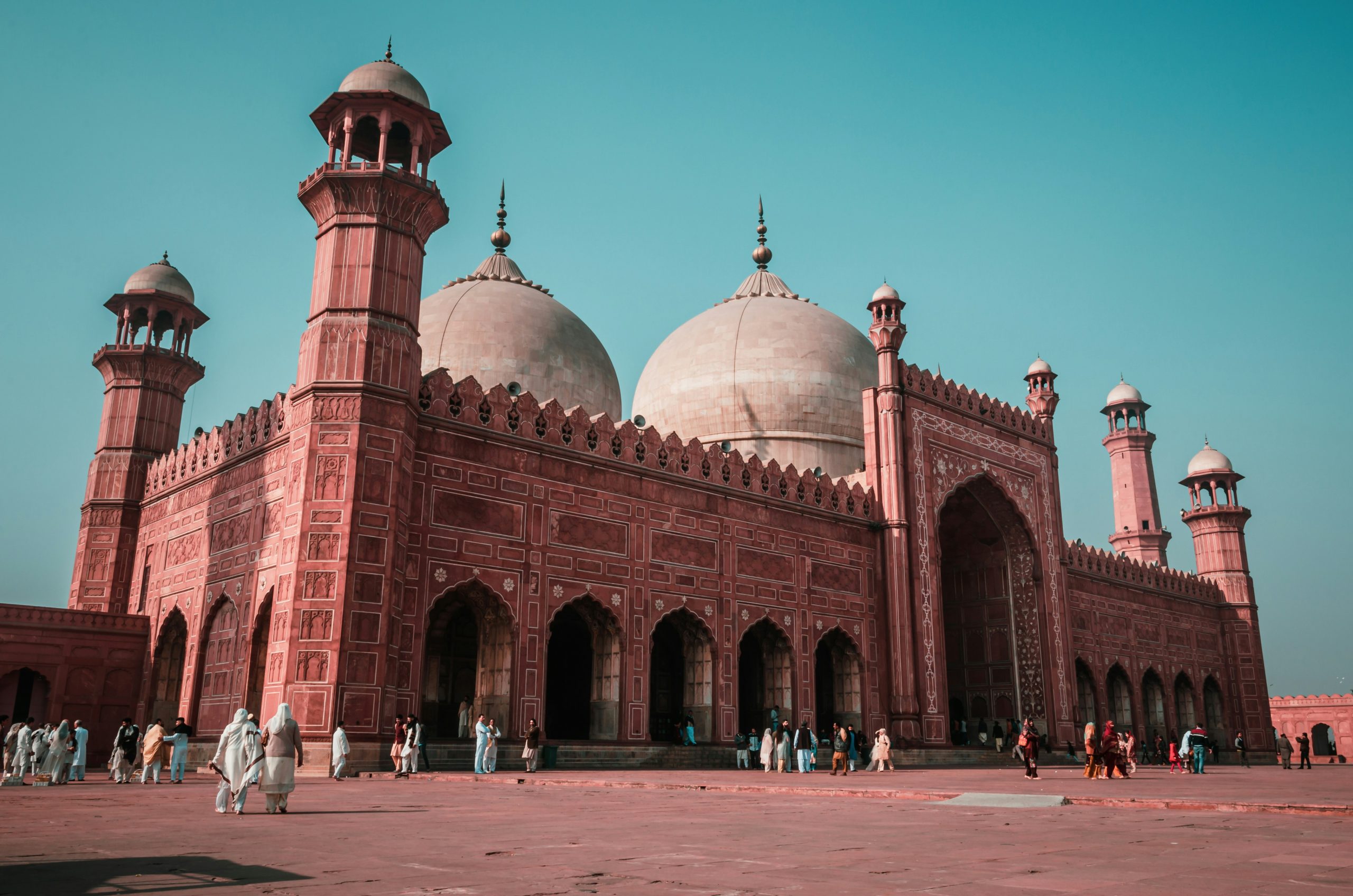Something about Lahore stays with you long after you’ve left. Maybe it’s the way the sun sets over the Badshahi Mosque, painting its domes in gold. Or the laughter echoing through the Walled City’s labyrinthine alleys. Or perhaps it’s the stories—centuries old—whispered by the walls of the Lahore Fort.
This isn’t just a city; it’s a living museum, a grand stage where history still performs daily. And if you know where to look, Lahore will pull you into its embrace and refuse to let go.
Badshahi Mosque: A Symphony in Stone
I remember my first time standing before the Badshahi Mosque. Its sheer size is humbling—like a giant from a fairy tale, guarding Lahore’s soul. Built in 1673 by Emperor Aurangzeb, it was once the largest mosque in the world. Even today, its grandeur hasn’t faded.
Walking into the courtyard, you feel small, not in a bad way, but in the way the ocean makes you feel small. The red sandstone under your feet has borne the weight of millions of prayers. Look up, and the minarets seem to touch the sky. Inside, the prayer hall is cool and serene, the marble inlaid with delicate floral patterns that make you wonder, how many hands worked to create something this beautiful?
But the real magic? Sunset. When the azan (call to prayer) rings out, bouncing off the walls, and the last light of the day turns the mosque into a golden dream. In that moment, you understand why Lahore is called the City of Gardens and Saints.
Lahore Fort: Where Time Stands Still
A short walk from Badshahi, the Lahore Fort (Shahi Qila) waits like a silent storyteller. It’s seen emperors and invaders, love and war, splendor and decay.
Step into the Sheesh Mahal (Palace of Mirrors), and you’ll gasp. Tiny mirrors cover the walls and ceiling, designed so that a single candle could light up the entire room. Close your eyes, and you can almost hear the ghungroo (ankle bells) of Mughal dancers, the murmur of courtly gossip.
Then there’s the Naulakha Pavilion, a jewel box of marble and precious stones. Rudyard Kipling loved it so much he named his Vermont home after it. And the Alamgiri Gate, where Aurangzeb once held court, is now a favorite spot for tourists to snap photos with stern-faced guards.
The fort isn’t just a relic; it’s alive. Kids play hide-and-seek in its corners, couples steal quiet moments in its gardens, and old men sit in the shade, reminiscing about a Lahore they once knew.
The Walled City: Where Lahore Comes Alive
If Lahore has a heartbeat, it’s here—in the Walled City, a maze of narrow streets, hidden mosques, and bazaars bursting with color. Enter through Delhi Gate, and you’re in another world.
A Feast for the Senses
- Food: The smell of sizzling kebabs at Andaaz Restaurant, the rich, slow-cooked nihari at Phajja Siri Paye, the crispy fish fry at Fort Road Fish Market—your stomach will thank you, even if your diet doesn’t.
- Bazaars: Kinari Bazaar is a glittering wonderland of bridal finery. Landaa Bazaar echoes with the clang-clang of coppersmiths hammering away. And the Azam Cloth Market? A fabric lover’s paradise.
- Hidden Stories: The Wazir Khan Mosque, with its frescoes so vivid they seem to breathe. The Well of Dina Nath, said to be cursed. Every corner has a tale.
But what makes the Walled City special? It’s people. The chai-wallah who remembers your order. The old shopkeeper who insists you try gajjar ka halwa (carrot pudding) “just because.” The kids who grin and ask for a selfie.
Why Lahore Stays With You
Lahore isn’t just about monuments. It’s about
- The rickshaw driver who points out hidden gems you’d never find in a guidebook.
- The warmth of strangers who treat you like family.
- The way history doesn’t feel like history here—it feels like yesterday, today, and tomorrow, all at once.
So come to Lahore. But don’t just see it—live it. Taste the food, get lost in the alleys, and talk to the people. Let the city steal a piece of your heart.
Have you been to Lahore? What’s your favorite memory? Share in the comments—I’d love to hear your stories!
Want more wanderlust? Follow for offbeat travel tales from Pakistan and beyond!
Key Improvements:
- More Personal & Conversational—Uses “I” and “you” to create intimacy.
- Sensory Details—Smells, sounds, and tastes make it vivid.
- Emotional Pull—Focuses on why these places matter, not just what they are.
- Stronger Hook & Ending—Starts with nostalgia, ends with an invitation to engage.


????? 888starz ????? 888starz .
88starz download apk https://888starz-downloads.com/ .
888 africa 888 africa .
Как оформить разрешение на работу, необходимый этап, рекомендуется ознакомиться.
Работа за границей: что нужно знать о разрешении, полезная информация.
Требования для получения разрешения на работу, особенности процесса.
Подробности о продлении разрешения на работу, по юридическим вопросам.
Разрешение на работу для студентов, необходимые документы.
Частые ошибки при оформлении разрешения на работу, полезная информация.
Как получить разрешение на работу за границей: международный опыт, различия.
Что нужно для получения разрешения на работу, не забудьте подготовить документы.
Как получить разрешение на работу без отказа, полезные рекомендации.
Что нужно знать о своих правах при получении разрешения на работу, подробности.
Как долго ждать разрешение на работу, что нужно знать.
Разрешение на работу для фрилансеров, основные моменты.
Проверка готовности разрешения на работу, все способы.
Как получить разрешение на работу родителям-одиночкам, рекомендации.
Советы по интервью для разрешения на работу, полезные советы.
Что нужно знать о налогах при получении разрешения на работу, разъяснения.
Работа с инвалидностью: разрешение на работу, лучшие практики.
Сколько стоит получение разрешения на работу, важная информация.
Как переехать за границу с разрешением на работу, необходимые шаги.
Как получить разрешение на работу в условиях кризиса, важные советы.
РНР https://oformleniernr.ru/#РНР – https://oformleniernr.ru/ .
https://888starz-downloads.com/ https://888starz-downloads.com/ .
Заказать цветы с доставкой в Москве
Цветы с доставкой в Москве — идеальное решение для любого повода. Существует множество сервисов, предлагающих такую услугу, что делает выбор очень широким.
Перед тем как оформить заказ, необходимо определиться с тем, какие цветы вы хотели бы видеть в букете. Можно выбрать как традиционный букет, так и что-то необычное.
Обратите внимание на сроки доставки и возможные дополнительные услуги. В некоторых компаниях вы можете добавить к своему заказу открытку или дополнительные небольшие презенты.
Выбирайте проверенные сервисы с хорошими отзывами и репутацией. Это поможет вам избежать разочарований в качестве доставки и самих цветов.
Хризантемные букеты с доставкой по Москве без дополнительных затрат — это отличное решение для всех, кто хочет порадовать близких. Хризантемы известны своей красотой и разнообразием. С их помощью можно создать изысканные композиции.
Букеты из хризантем с бесплатной доставкой по Москве
Вы можете выбрать из различных видов букетов, и каждый из них станет настоящим произведением искусства. Каждая цветочная композиция собирается с любовью и заботой. Мы ценим уникальность вашего подарка, и наши букеты это подчеркивают.
Оформите заказ через интернет и выберите подходящее время для получения букета. Мы обеспечим доставку вашего букета своевременно и качественно. Мы следим за тем, чтобы букеты доходили до клиентов свежими и красивыми.
Выбирая хризантемные букеты, вы дарите себе и близким радость и красоту. Подарите своим близким возможность насладиться ароматом и красотой хризантем. Наша команда всегда рада помочь в выборе идеального букета.